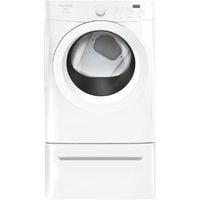Frigidaire stackable dryer not heating. If your Frigidaire stackable dryer isn’t heating at all, there are a number of potential issues.
The first thing you need to do is remove the back right corner of the machine that contains the heating element housing and then check for continuity using a multimeter.
If there’s no continuity, replace it with the thermal fuse located nearby. Here are some more common reasons your clothes dryer isn’t working properly and their corresponding solutions below:
Frigidaire stackable dryer not heating

Here are some common reasons that your Frigidaire stackable dryer maybe not working properly and what you can do to fix them:
Defective Thermal Fuse
The thermal fuse is a safety device that protects the dryer from overheating.
Something which may be overlooked, however, is that when the thermal fuse blows, it’s an indication of a restricted exhaust venting system.
Always check the dryer venting system when replacing a blown fuse to ensure there isn’t debris obstructing it as this could have a negative effect on your clothes.
A multimeter can be used to test it for continuity by checking to see if there’s still electricity flowing through the device (the path being continuous).
If you are unsure about how to do so, ask one of our trusted technicians to provide you with their professional opinion.
Faulty Gas Valve Solenoid
Gas dryers have two or more solenoids for controlling the gas valve. In order to allow gas to flow into the burner assembly, the gas valve solenoids open the gas valve ports.
In the event of a gas valve solenoid failure, the dryer will not heat.
In order to determine whether or not the solenoids of the gas valve have failed, check the igniter.
If the igniter glows but doesn’t ignite, one or both of your gas valve coils are defective and should be replaced as a pair because they are connected to each other and so replacing only one will result in a failure of the other before long.
Replace Flame Sensor
A flame sensor on a gas dryer can be tricky to fix. The flame sensor detects the heat of the flame in order to get the dryer operational.
To check if the flame sensor is faulty, one has to pinpoint whether or not there’s a short circuit present in the sensor at room temperature. If that is indeed true, then it’s more than likely that you need to replace it with a new one.
Igniter has burned out
The igniter is a small electronic device in the gas burner assembly that provides the spark to ignite the natural gas. The igniter may burn out, preventing your dryer from heating.
To determine if the igniter needs replacement, use a multimeter to test for continuity from one wire to the other at both ends of the unit and ensure that it carries current.
If there’s no current, you will need to replace it; however, you may want to check for blockage and proper airflow before replacing it as well.
Incoming Power issue
If your dryer is not heating, the incoming power voltage may be to blame. Electric dryers require 120 volts AC, which comes in the form of two ‘legs’ that need to carry current.
While it’s common for a fuse to blow or trip when there’s a problem with only one leg, running a multi-meter at the outlet can reveal whether electricity is entering your dryer to heat its interior.
Heating Element problem
Prior to entering the dryer drum, the air is heated by the heating element. In time, excess moisture or dirty lint and dust will eventually cause the heating element to burn out, resulting in a non-heating dryer.
A multimeter can be used to troubleshoot heating element issues.
If there is no continuity in the heating element and it is blackened in color, then you will need to replace it by removing the screws and pulling out the old one before putting a new one back in place, primarily using your screwdriver.
Timer Fault
If the dryer is not heating, inspect the timer to see if it’s defective. Unplug your dryer and install a multimeter, making sure that the power is shut off to the dryer before you measure resistance values.
Ensure that all other components are working properly (including airflow, as airflow restrictions can cause a lack of heat), then check resistance values on the timer.
If there isn’t continuity between wired sections on the coil (i.e., lint or debris may cause open circuits in your wiring) clean this area thoroughly with a vacuum cleaner and needle-nosed pliers in order to test for an open circuit.
Replace the relevant component if you diagnose this as a problem; if testing shows continuity between each section of the coil, your dryer still does not heat up when operated.
There is something wrong with your heating element, and you should repair or replace it accordingly.
Main Control Board not working properly
The main control board might be faulty, but this is rare. Ensure that the other components (controllers, sensors, etc.) are in good working order before replacing the main control board.
Replacing the main control board is necessary if all other parts are functioning properly.
It’s not easily testable and cannot be individually probed for defects as such, so it’s a time-consuming task to check every single component if having already replaced one that displayed warning signs.
Related Guides

